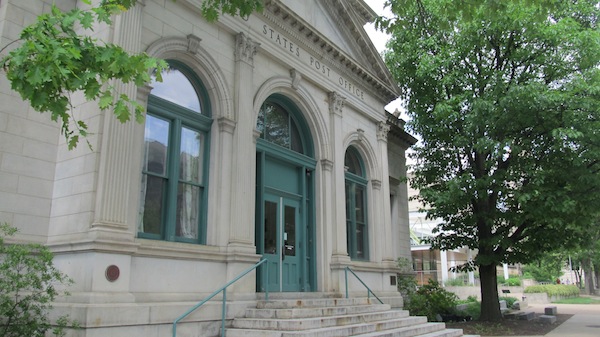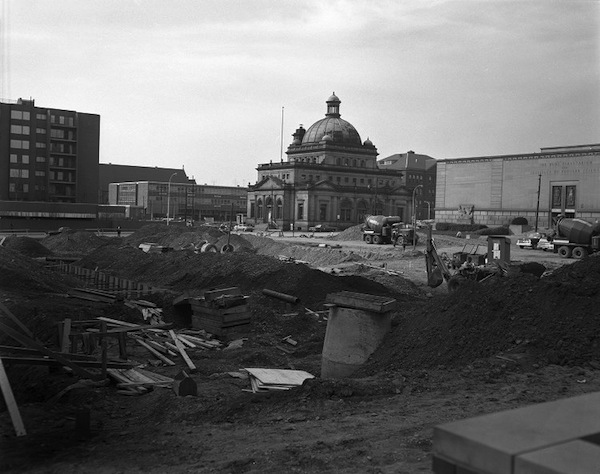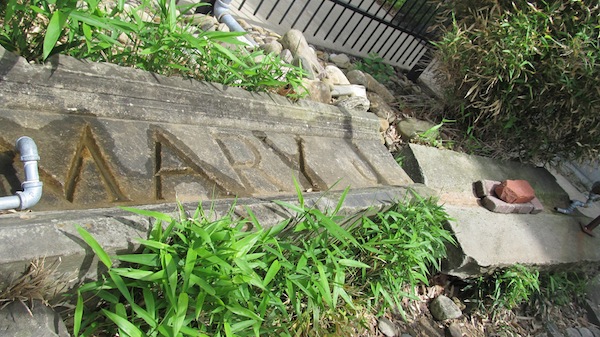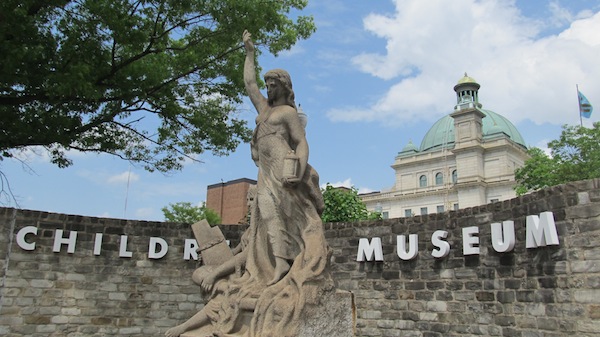
Latest News
-
Children’s Museum of Pittsburgh: Fourth in a Series of PHLF’s Greatest Saves in 50 Years
PHLF turned 50 on September 30, 2014. Intern Lauren Van Zandt, a Public History graduate student at Duquesne University, is sharing the stories of some of PHLF’s “Greatest Saves.” Help us celebrate 50 years of Pittsburgh renewal with a donation to our 50th Anniversary Fund. Click here.
Staying on the North Side, this month’s “Greatest Save” features the Allegheny Post Office that PHLF saved and transformed into the Old Post Office Museum in the early 1970s and then eventually donated to the Children’s Museum.
Elise Oberdick, current Educational Programs Coordinator for the Children’s Museum and a former PHLF intern, gave me a tour and talked to me about the role architecture and history play in the museum’s interpretation.
A bit of background first: the Allegheny Post Office, designed in the Italianate style by William Martin Aiken, was completed in 1897 in Allegheny, an independent city until its annexation to Pittsburgh in 1907. The Post Office, like most of Allegheny’s central business district, came under threat in the mid 1960s as acres of buildings were demolished to make way for Allegheny Center. Although the Post Office was described as “doomed” in PHLF’s 1967 edition of Landmark Architecture of Allegheny County, trustees and staff successfully negotiated a last-minute “save” with the Mayor and Urban Redevelopment Authority so the historic landmark was not demolished. The catch? PHLF had to buy the building, then in ruinous condition, for $116,000 and restore it and put it to good use.
PHLF opened the Old Post Office Museum in 1972 and created a mezzanine floor to house staff offices. Many of the architectural materials on display at the Children’s Museum are from this time. PHLF displayed salvaged materials from demolished Pittsburgh buildings; decorative architecture from Ridge Avenue mansions; stained glass windows from the Henry W. Oliver mansion; and the “Ladies of Stone” from the less-fortunate post office in Downtown Pittsburgh that was demolished.
In the late 1970s, just as PHLF was beginning to develop Station Square on Pittsburgh’s South Side, the Junior League of Pittsburgh was eager to establish a children’s museum in Pittsburgh. PHLF suggested that the Junior League establish its museum in the Old Post Office, since PHLF planned on relocating its offices to Station Square. The Children’s Museum took root and grew, and PHLF leased the entire Old Post Office building to the Children’s Museum. In 1991, PHLF donated the building to the Children’s Museum so that they could stop paying rent and apply the savings to exterior restoration, landscaping, and educational programs.
If I learned anything from my tour with Elise, it’s that the Children’s Museum is a poster child (no pun intended) for adaptive reuse. The influence of historic preservation is evident throughout the building complex that now unites three buildings from three centuries––the 19th, 20th, and 21st century––and is LEED certified. Architectural artifacts and old building features are incorporated throughout the museum. What’s great about the use of architectural artifacts in the museum is that the past isn’t just on display, it’s in use. The Allegheny Post Office vault is now a kiln room. Pieces of architectural salvage have been used to construct a wall and serve as playing and learning equipment to learn about water flow and damming.
Beyond its educational role, the Children’s Museum is an important part of the North Side community because it serves as a familiar, beloved architectural anchor and is a major player in neighborhood renewal efforts. Allegheny Commons has seen dramatic changes in the past decades, but in all of its forms, the Post Office building has served as a sustaining link between the past and the future for residents. The Children’s Museum shows the flexibility of historic preservation; buildings don’t have to be static structures preserved in amber in order to function as historic landmarks.
-
Thank You Interns
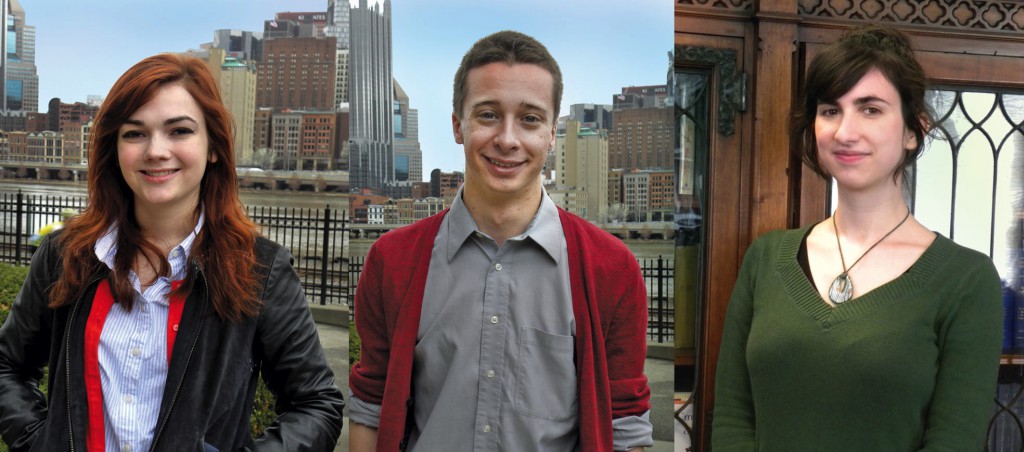
Two interns from the University of Pittsburgh––Kirsten Armstrong and Luke Meyer––and a graduate student from Duquesne University––Lauren Van Zandt––volunteered their time as interns with PHLF, January through April. They helped especially with PHLF’s educational programs and in writing a series of stories on “PHLF’s Greatest Saves,” in honor of our fiftieth anniversary.We thank Kirsten, Luke, and Lauren for their time and energy on behalf of PHLF and wish them much success. They summed up the value of their experience with PHLF in the following comments:
“During my internship with the educational department of PH&LF, I grew as both a professional and a person because of the focus PHLF has on Pittsburgh’s architectural history. Through our educational programs, I not only got to teach and work with children in a way that helped them connect with their surroundings, but I also got to experience that same sense of connection. In addition, I was introduced to members of the preservation community, such as stained glass craftsman John Kelly and CMU professor Dr. Volker Hartkopf.” ––Kirsten Armstrong (Architecture, Historic Preservation; University of Pittsburgh)
“At PHLF I gained valuable experience by assisting in preservation-minded educational programs while attaining insight into the complexity of operating a nonprofit organization. I met many passionate, hard-working people from whom I learned so much. I was amazed by the number of programs that PHLF does for the education and preservation of Pittsburgh’s history.” –– Luke Meyer (Urban Studies; University of Pittsburgh)
“The most valuable aspect of my internship was how it pushed me out of my comfort zone. I had no experience judging middle schoolers’ architectural projects, interviewing people for articles, or preparing a book for publication. I’ve really appreciated the diversity of the projects I’ve had the opportunity to work on. –– Lauren Van Zandt (Public History; Duquesne University)
-
Windows Restored at “Woodville Plantation”
Thanks to a Keystone Historic Preservation Grant, Neville House Associates was able to fund the restoration of 23 windows in the National Historic Landmark historic house museum dating back to the eighteenth century.
“This may be some of the earliest window glass made in the Pittsburgh area,” said John Kelly, “and we were very careful to document our entire restoration process. Restoring the windows presented a unique challenge because the glass is very thin, between 1/32nd and 1/16th of an inch.”
Kelly Art Glass removed the windows from “Woodville Plantation,” the John and Prestley Neville House in Collier Township, on December 30, 2014 and carried out meticulous restoration work over the winter months. Fifty broken panes were repaired and new pieces of full restoration glass were cut and fit into place. “Full restoration glass gives us the best visual character,” said John Kelly. All the windows were reinstalled by April 17, 2015––in time for the summer schedule of Sunday events open to the public.
-
Search Buildings of Western PA Using PHLF Database
The Buildings of Western Pennsylvania Searchable Database is a resource containing over 1,700 data fields documenting the contents of the collection of research materials assembled for the writing of Buildings of Pennsylvania: Pittsburgh and Western Pennsylvania (University of Virginia Press in association with the Society of Architectural Historians, 2010).
Compiled in File Maker Pro, the Database is a spreadsheet style document that allows users to search through materials pertaining to important architecture, historic personages, town histories, correspondence, National Register documents, maps, floor plans, photos, newspaper articles, and many other records from 32 western Pennsylvania counties.
Of these media types, newspaper articles and printed histories of various kinds comprise the majority of the collection. The intent of the Database is to allow researchers not only a quick means to look up information in the collection, but a means to gain a general sense of what materials can be found within the collection in a more comprehensive and detailed way than a finding aid would allow.[1]
All entries within the database are comprised of five fields. From left to right, they are box number, folder number and name, the type of record or records, the specific name of the record or records, and, if available, the date of publication. Thus, an example entry might read 1; Folder 5: Erie County-Erie City; National Register of Historic Places Registration Form; Boston Store; 1996. Most entries have multiple records per generic record heading (i.e. several specific brochures in the fourth column under the category “Brochures” in the third) for the sake of convenience.
While the Database was compiled to be comprehensive, there are a few notes to be made on its scope. Any and all historical information from a variety of sources is listed under the heading “General Information” by topic, as opposed to the type of record. Field notes, which are present in almost every box and folder, have not been listed largely as a result of their idiosyncratic nature; it should generally be assumed that topics covered under “General Information,” will, however, have field notes pertaining to them. Various photos and illustrations that depict unknown buildings from unknown locations are also present, and have been largely excluded. Users should, as with field notes, assume that photos relating to the folder topics will be present. Finally, though redundant copies of several items exist, generally only one copy is listed, in the first location it is present from Box 1, Folder 1 onward through Box 17, Folder 6.
The Database can be searched in a number of ways. The best way to find items is to list search terms in the search bar in the upper right hand corner of the file. Users can input as few or as many specific search terms as they would like to narrow results. For example, “Washington” will return all entries that contain the word “Washington” across all fields, “Washington County” all entries with “Washington” or “County,” “Washington County Newspaper Articles” all newspaper-based entries from Washington County, and “Washington County Newspaper Articles 2003” all articles from the year 2003. Note, however, that a search like “Washington County” will return results on information about George Washington within Allegheny County. This formula allows users to, for example, search for specific articles on specific topics from a given year, all brochures from a given town in a county, or all highway maps across all counties.
When searching terms, the following words may prove especially useful, though users are encouraged to input specific names of towns, individuals, buildings, bridges, and other more particular topics––Pittsburgh, any Pittsburgh neighborhood, brochures, handbills, general information, maps, National Register documents, scans of printed books, lists (of properties), menus, photos; illustrations, blueprints, floor plans, correspondence (which often contains information on buildings) sent to Lu Donnelly, principal author and volume editor, surveys, newspaper articles (primarily from the Pittsburgh Post-Gazette, Pittsburgh Tribune Review, Pittsburgh Business Times, and Pop City Media), journals, magazines, and booklets.
Thirty-one Western PA counties are included in the published book, Buildings of Pennsylvania: Pittsburgh and Western Pennsylvania: Allegheny, Beaver, Butler, Armstrong, Indiana, Westmoreland, Fayette, Greene, Washington, Cambria, Blair, Centre, Huntingdon, Fulton, Bedford, Somerset, Warren, McKean, Potter, Clinton, Cameron, Elk, Forest, Clarion, Jefferson, Clearfield, Erie, Crawford, Venango, Mercer, and Lawrence. Research was done on thirty-two counties but Juniata County was moved to Buildings of Pennsylvania: Philadelphia and Eastern Pennsylvania (2010), although some research material remains in this collection.
Ryan Henderson
Duquesne University
2015
[1] The Finding Aid for Buildings of Western Pennsylvania Research Collection was completed June 2009 and can be consulted in the James D. Van Trump Library, Pittsburgh History & Landmarks Foundation.
-
2015 Historic Religious Properties Grant Recipients
The Historic Religious Properties Grant committee has awarded $59,301 in matching grants for physical improvements to nine Allegheny County historic religious properties. Five other congregations were awarded technical assistance grants for ongoing building restoration and maintenance projects.
These funds are critical in helping owners of historic religious properties undertake and plan a variety of physical building improvements, which can range from stained glass to façade restoration or roof repairs.
Our thanks to PHLF members and to all who donate generously to make this program possible every year. The Historic Religious Properties Grant program is the only one of its kind in Allegheny County that helps religious organizations make physical improvements to their historic buildings.
This year’s grant recipients are:
Physical Improvement Grants
$6,740 to All Saints Polish National Catholic Church in Carnegie for stained glass restoration
$1,550 to the Byzantine Catholic Seminary in Observatory Hill for interior masonry repair of bell tower
$8,000 to Central Presbyterian Church in Tarentum for stained glass restoration
$9,100 to Epiphany Catholic Church in the Hill District for replacement of a slate roof
$6,740 to Fairhaven Methodist Church in Overbrook for stained glass window restoration
$5,671 to Pittsburgh Mennonite Church in Swissvale to replace a small flat roof and gutters
$5,500 to St. Philip Church in Crafton to repair ventilators in stained glass windows
$8,000 to St. Thomas Church in Oakmont for repointing of the bell tower and restoration of the clock face
$8,000 to Trinity Evangelical Lutheran Church in Wexford for stained glass window restoration
Technical Assistance Grants
The Church of the Redeemer in Squirrel Hill to help develop a maintenance priority list
Greater Allen AME in Brighton Heights to assist in prioritizing maintenance projects and choosing qualified contractors
Just Right Ministries in Wilmerding to recommend repairing its steeple roof instead of demolition
Presentation of Christ Greek Orthodox in East Pittsburgh, to assist in determining the best approach in repairing its windows
St. Paul of the Cross Monastery on the South Side Slopes, to recommend repointing exterior walls
-
The Mexican War Streets: Third in a Series of PHLF’s Greatest Saves in 50 Years
PHLF turned 50 on September 30, 2014. Intern Lauren Van Zandt, a Public History graduate student at Duquesne University, is sharing the stories of some of PHLF’s “Greatest Saves.” Help us celebrate 50 years of Pittsburgh renewal with a donation to our 50th Anniversary Fund. Click here.
Traveling back to the North Side, this month’s Greatest Save is the Mexican War Streets. PHLF began working with the Mexican War Streets area around the same time as Manchester, but in this neighborhood their approach differed. Similarly to Wilkinsburg, PHLF began purchasing and renovating houses in the Mexican War Streets, then utilizing the residences as low-income housing. In 1969, when PHLF bought their first property at 1220 Monterey Street, this was the first time this low-income restoration technique had been used in the United States.
 Almost 50 years later, the Mexican War Streets is one of Pittsburgh’s most well-known and sought out historic neighborhoods. I met with Kate Kay, president of the Mexican War Streets Society, to talk about the neighborhood today. One thing that struck me was the importance of the historical character of the neighborhood in attracting residents; Kate told me that tenants are willing to pay a premium for living spaces that have unique historical and architectural features.
Almost 50 years later, the Mexican War Streets is one of Pittsburgh’s most well-known and sought out historic neighborhoods. I met with Kate Kay, president of the Mexican War Streets Society, to talk about the neighborhood today. One thing that struck me was the importance of the historical character of the neighborhood in attracting residents; Kate told me that tenants are willing to pay a premium for living spaces that have unique historical and architectural features.
 The downside to this neighborhood appeal is the increased incentive for development. While there are a number of developers who are interested in doing small-scale historically-appropriate construction, Kate has been worried about calls to demolish large swaths of buildings in order to replace them with modern anachronistic buildings. The area within the City Historic District is safe from this kind of development, but there are a large number of historically-significant but vacant properties in the adjacent neighborhoods that are under threat.
The downside to this neighborhood appeal is the increased incentive for development. While there are a number of developers who are interested in doing small-scale historically-appropriate construction, Kate has been worried about calls to demolish large swaths of buildings in order to replace them with modern anachronistic buildings. The area within the City Historic District is safe from this kind of development, but there are a large number of historically-significant but vacant properties in the adjacent neighborhoods that are under threat.One of those areas is Boyle Street, just outside the Federal Street boundary of the Mexican War Streets. Walking down Boyle Street is like traveling through time: as you walk down the street, the houses transition from 1860s Civil War-era, to Victorian, to Italianate.
 Unfortunately, many of the buildings on Boyle Street are currently vacant, and therefore at high risk of demolition. Kate and the Mexican War Streets Society are hoping to expand the boundaries of the City Historic District to protect the whole Mexican War Streets neighborhood as well as encouraging preservation over demolition in order to protect and revitalize vulnerable areas of the North Side. As Kate told me, “Preservationists need to stick together.” It took a community of preservationists and residents to make the Mexican War Streets what it is today, and it will take continued cooperation to ensure that this beautiful, unique area is preserved for the future.
Unfortunately, many of the buildings on Boyle Street are currently vacant, and therefore at high risk of demolition. Kate and the Mexican War Streets Society are hoping to expand the boundaries of the City Historic District to protect the whole Mexican War Streets neighborhood as well as encouraging preservation over demolition in order to protect and revitalize vulnerable areas of the North Side. As Kate told me, “Preservationists need to stick together.” It took a community of preservationists and residents to make the Mexican War Streets what it is today, and it will take continued cooperation to ensure that this beautiful, unique area is preserved for the future.Spring marks the beginning of a host of Mexican War Streets activities. Although the neighborhood is known for its house tours and community gardens, the Mexican War Streets Yard Sale has quickly become a huge North Side event. Last year over 2,000 people from four states gathered for the event’s inaugural year. The yard sale will be held June 6 from 9:00 a.m. – 2:00 p.m. throughout the neighborhood. It would be a great time to walk along Monterey, Buena Vista, and Palo Alto streets, among others, to see the progress that has occurred over five decades, thanks to the efforts of PHLF, the Mexican War Streets Society, and so many people.
-
Wilkinsburg: Second in a Series of PHLF’s Greatest Saves in 50 Years
PHLF turned 50 on September 30, 2014. Intern Lauren Van Zandt, a Public History graduate student at Duquesne University, is sharing the stories of some of PHLF’s “Greatest Saves.” Help us celebrate 50 years of Pittsburgh renewal with a donation to our 50th Anniversary Fund. Click here.
Last month I wrote about my own neighborhood, Manchester. This month I’ll be talking about PHLF’s Greatest Hits in Wilkinsburg, which is in the early stages of what promises to be a Manchester-like revitalization. Walking through Wilkinsburg with Louise Sturgess and the other PHLF interns, I almost lost count of all the recent renovations, business ventures, and projects going on around us. In addition to historic preservation, PHLF’s projects in Wilkinsburg are meant to create partnerships, drawing involvement from residents and stakeholders through preservation work.

One of the most unique (and cutest) is Piano Place, a park and community garden designed by Ronald Butler, a grade 7 PHLF CampDEC participant. PHLF partnered with residents of Hamnett Place in Wilkinsburg, Allegheny Grows, and PHLF member Russ Coe to design, fund, and install Piano Place. Landscape architect Evaine Sing was instrumental in turning the design concept for Piano Place into reality.

 Piano Place sits next to the Wilson House, one of four residences recently renovated by PHLF on Jeanette and Holland Streets. As an example of how PHLF’s involvement in a neighborhood can have a cascading effect, Louise pointed out houses directly across from PHLF-renovated residences that were being fixed-up by other homeowners.
Piano Place sits next to the Wilson House, one of four residences recently renovated by PHLF on Jeanette and Holland Streets. As an example of how PHLF’s involvement in a neighborhood can have a cascading effect, Louise pointed out houses directly across from PHLF-renovated residences that were being fixed-up by other homeowners. 
 One of the most exciting projects I saw was the Landmarks Preservation Resource Center. Located in a former Packard Auto dealership and mechanic’s shop on Rebecca Avenue, the Resource Center is an amalgamation of classroom space, community center, art studio, library, and technology hub. Seeing the sculptures of artist James Shipman and the restored shields from the former Manchester Bridge outside the building really emphasized the impression of reuse and rebirth as a source of beauty and creativity.
One of the most exciting projects I saw was the Landmarks Preservation Resource Center. Located in a former Packard Auto dealership and mechanic’s shop on Rebecca Avenue, the Resource Center is an amalgamation of classroom space, community center, art studio, library, and technology hub. Seeing the sculptures of artist James Shipman and the restored shields from the former Manchester Bridge outside the building really emphasized the impression of reuse and rebirth as a source of beauty and creativity. 
Two of PHLF’s most ambitious projects in Wilkinsburg are the Crescent and Falconhurst Apartments. The Crescent Apartments, the largest renovation PHLF has taken on since Station Square, were completed in 2011. Work on the adjacent Falconhurst Apartments began this winter. Using a combination of public and private funding, these renovations epitomize the power of historic preservation to strengthen neighborhoods and enrich residents’ lives.
 There’s a lot of work ahead in Wilkinsburg, but PHLF’s efforts have made a very definite step forward that will make it easier for others to follow. And I have to say, after walking and driving around Wilkinsburg this January, if I ever decide to buy a house in Pittsburgh, I think Wilkinsburg is going to be one of the first places I look.
There’s a lot of work ahead in Wilkinsburg, but PHLF’s efforts have made a very definite step forward that will make it easier for others to follow. And I have to say, after walking and driving around Wilkinsburg this January, if I ever decide to buy a house in Pittsburgh, I think Wilkinsburg is going to be one of the first places I look. -
PHLF’s Career Awareness Program Motivates Fourth Graders to Explore their School and Community
“This was very worthwhile. Children made connections between their education and their career future. … PHLF does a great job. Always such a pleasure to have their programs come into the schools––students learn a lot.”
––Pittsburgh Banksville and Pittsburgh Phillips teachers, March 23 & 26, 2015
Below is a gallery of 20 photos of fourth-grade students from Pittsburgh Phillips and Pittsburgh Banksville participating in PHLF’s award-winning career awareness program, “People Who Work to Improve Our Communities.” Through colorful posters, tools of the trade, maps, and discussions about their school and community, students begin to understand how the skills and knowledge they are acquiring in school will help them become engineers, bankers, architects, lawyers, HVAC technicians, electricians, contractors, public officials, etc.: people who work to improve their communities.
PHLF is able to offer the Career Awareness and other educational opportunities to a number of Pittsburgh Public Schools through May 2015, thanks to funding support from BNY Mellon Foundation of Southwestern Pennsylvania and thirteen businesses through the state’s EITC program.

